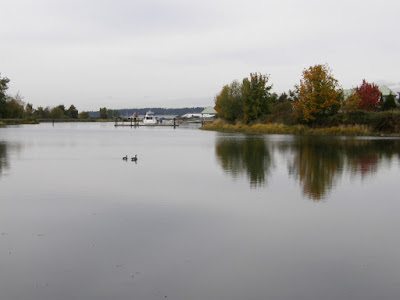So elegant in black and white!
 |
| Bald-faced hornet, Dolichovespula maculata. On waxberry flowers, Symphoricarpos albus. |
 |
| Waxberry, aka snowberry, bearing both fruit and flowers. |
This is one of the times I really appreciate the Latin names; this wasp (not a true hornet, despite the English name, really a yellowjacket, without the yellow jacket) goes by many common names, probably depending on where the namers met it first. I knew them, growing up, as Yellowjackets; on iNaturalist, it's a Bald-faced hornet (where "Bald" comes from "piebald, meaning white, not hairless); or it goes by Black Jacket, White-faced hornet, Bald-faced Aerial Yellowjacket (this, on BugGuide), White-tailed Hornet, and according to Wikipedia, Spruce wasp and Bull wasp. They all answer to Dolichovespula maculata.
The white berries, Symphocarpus albus, are commonly called Snowberries, maybe because of the colour and also because they stay on the bush all winter, or Waxberries; they do have a waxy feel. In some places, they go by the name of Ghostberry. The flowers are inconspicuous and don't give rise to another name, at least.
 |
| Same wasp, different clump of berries and buds. |
~~~~~~~~~~~~~
Tan elegante, esta avispa, vestida en negro con blanco.
- Avispón de Cara Blanca, Dolichovespula maculata. Con flores de Symphocarpos albus.
- Flores y bayas de S. albus.
- La misma avispa, con otro racimo de flores y bayas.
Con especies como estas dos, que se encuentran en abundancia sobre una gran extensión del continente, el nombre científico adquiere importancia, porque se conocen por muchos distintos nombres. Esta avispa se conoce, en español, como la Avispa de Cuerpo Largo, o el Avispón de Cara Blanca. En inglés (y traducciones directas como las que se encuentran en Wikipedia) es la avispa de Cola Blanca, el avispón de la chaqueta amarilla (y esta es una de las chaquetas amarillas, pero le falta la chaqueta amarilla) o la avispa del aire chaqueta amarilla (esto según BugGuide), la avispa abeto picea, o la avispa toro (estos dos últimos nombres en Wikipedia). Es una avispa, y un avispón a la vez. Los avispones pertenecen a una famila de avispas grandes. Dolichovespula maculata evita tanta confusión.
Estas avispas son las que hacen los nidos de papel del tamaño de una pelota de futbol.
El arbusto Symphoricarpos albus no tiene nombre común en español. Es una planta común de los bosques pluviales de Canadá y del norte de los Estados Unidos, y en inglés lleva los nombres de Baya de las Nieves, Baya de Cera, o Baya Fantasma, estos nombres a causa del color blanco de las bayas, su persistencia durante el invierno, y su textura como de cera. Las flores no llaman la atención, y por eso no han inspirado más nombres.































